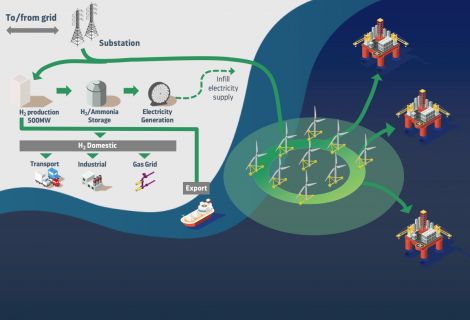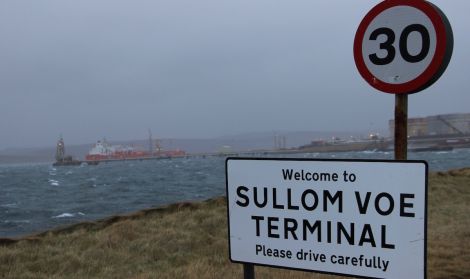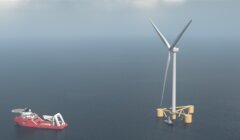Energy / Offshore wind developer confident of securing licence for floating turbines west of Shetland
Shetland Greens, however, call for more “meaningful involvement of the community” in projects like Cerulean Winds’ ambitious plan
THE DEVELOPER behind plans for a floating wind farm 100km west of Shetland and a hydrogen plant at Sullom Voe believes the chances of gaining the necessary licences are “very good”.
Dan Jackson of Cerulean Winds also insisted that the technology for large 14-15MW turbines will be be ready in time for the project potentially being completed in 2026.
But the local branch of the Scottish Greens says there needs to be more “meaningful involvement of the community” in these type of projects – while it also questioned the effectiveness of hydrogen in tackling the climate emergency.
On Tuesday it was announced that Cerulean Winds is proposing to install 200 wind turbines west of Shetland and in the central North Sea, which would power a hydrogen plant at Sullom Voe.
A key focus of the £10bn project – which would not connect to the national grid – would be to power oil platforms using wind energy, assisting the industry towards its goals of becoming net zero in the next couple of decades.
Jackson told Shetland News that the “impact of not proceeding with the scheme should the regulator decide against Cerulean are catastrophic, continued paralysis of the oil and gas industry, significant impact on oil and gas jobs”.
The ambitious plan has a strong tie-in to the ORION project, which aims to make the isles clean energy hub in the move away from fossil fuels and is lead by Shetland Islands Council (SIC) alongside the Oil and Gas Technology Centre, Highlands and Islands Enterprise and the University of Strathclyde.
Among its aims is to electrify oil platforms and produce industrial quantities of hydrogen for use as fuel.
Project coordinator Gunther Newcombe said ORION has been working “collaboratively” with Cerulean Wind since its inception in April last year.
The council’s future energy manager Douglas Irvine said Cerulean’s interest “illustrates the potential scale of this type of development and also the interest in the windy region around Shetland”.
Become a member of Shetland News
“This perhaps indicates the speed of change in the energy industry and the potential economic benefits for Shetland,” he added.
“It is of course early days and the key priority for Cerulean is to obtain the engagement with the regulatory bodies that they seek.”
Irvine said that SIC leader Steven Coutts was right to point out that any development of the site has to consider the interests of other marine users such as the fishing industry.
When asked if Cerulean would be undertaking any consultation with the Shetland community, Jackson said: “The Cerulean team has had a close and regular dialogue with the Orion project team and members of the SIC.
“In due course we would expect to broaden this out to incorporate many other stakeholders on Shetland.”
The ORION project was brought up at an SIC meeting on Tuesday, with Lerwick member Stephen Leask asking if the team could be more proactive in plugging the benefits of the scheme to the community.
Infrastructure director John Smith said one balance being struck was around a “broad range of possible futures” being described, and the uncertainty around which may be achieved.
“We’re virtually completely dependent on diesel, marine fuel oil and hydrocarbons as a community at the moment. That shift from that has to be made one way or another.”
Smith suggested that to an extent the council is powerless to prevent some projects linked to the energy sector from going ahead, but “we have the ability to describe what’s important to Shetland”.
Cerulean’s plans received a mixed welcome on social media when announced on Tuesday, however, with some questioning the size of the development and its proximity to Shetland – which is already going to be home to the 103-turbine Viking Energy wind farm.
Shetland Greens co-coordinator Debra Nicolson said that green hydrogen production has only a “limited role” to play in efforts to tackle the climate emergency, due to its “relative inefficiency when compared to electrification”.
“As a fuel, hydrogen will have a use only in aviation and long-distance shipping but for almost every other aspect of energy use, electrification is the answer,” she added.
“We believe also that there needs to be more meaningful involvement of the community in projects that will affect them to avoid the controversy and conflict of, and learn from, projects like Viking Energy.”
Jackson, meanwhile, said the turbines to the west of Shetland would be around 100km from land.
He explained that floating wind has anchor chains and anchors on the seabed, which is different to fixed offshore wind farms that penetrate the seabed.
The plans include 200 turbines up to 15MW in power. In contrast, the Viking Energy turbines will only be able to produce 4.3MW.
“The economic benefits of larger turbines cannot be overstated, it means that the Cerulean floating wind development is financeable from the financial markets without the need for government subsidies or CfDs.”
Cerulean Winds has submitted a request to the Scottish Government’s Marine Scotland agency for seabed leases.
Jackson said he is confident the plans will get the necessary approval. “Cerulean have been in a dialogue with all the stakeholders in the regulatory framework, including Marine Scotland over the last year,” he said.
“The proposed scheme incorporates many of the requirements that have come out of those meetings. Furthermore, the Cerulean scheme meets the requirements of the North Sea transition deal, which mandates significant emissions reductions by 2027.”
A spokesperson for the Scottish Government said that a marine plan for offshore wind energy published last year “stated the need to bring forward a new planning and leasing round to allow projects similar to the one proposed by Cerulean Winds to progress”.
“Marine Scotland are currently working to facilitate the most appropriate planning and leasing process to enable the wider objectives of North Sea decarbonisation.”
Jackson admitted, though, that the timescales are “tight”. He said assuming the award of leases in quarter three of this year, Cerulean will reach financial close in early 2022 – aiming for first electrification in 2024, final commissioning and completion two years later.
But could the plans have much impact on the average person in Shetland? Cerulean says the benefits to Shetland would include “lower cost energy for local people to job creation”.
The turbine parts would head offshore via Shetland and be serviced in the isles too, potentially bringing new work to the isles.
Jackson also said the fishing industry has been one sector taken into account when deciding the site locations.
“We have been in a close dialogue with Marine Scotland to understand the many constraints on site selection and are confident the Cerulean sites proposed minimise the environment and economic impact to other uses.”
With a £10 billion price tag, the project does appear to come with significant question marks when it comes to finance, but Jackson insisted it was in a good place to cover the costs.
“The Cerulean scheme will be fully financed using infrastructure finance from the financial markets,” he said.
“We consider the project being ‘bankable’ as an absolute requirement and so spent a lot of the last year working with our advisors to ensure we can demonstrate this ahead of putting the proposal in to the regulator.”
Jackson said he was unable to provide any names of the partners behind the scheme due to commercial sensitivity.
“At this stage Cerulean are keen that the reader understand the urgency for the approval of the scheme, the benefits to Scotland and the benefits to Shetland.”
Become a member of Shetland News
Shetland News is asking its many readers to consider paying for membership to get additional features and services: -
- Remove non-local ads;
- Bookmark posts to read later;
- Exclusive curated weekly newsletter;
- Hide membership messages;
- Comments open for discussion.
If you appreciate what we do and feel strongly about impartial local journalism, then please become a member of Shetland News by either making a single payment, or setting up a monthly, quarterly or yearly subscription.











































































